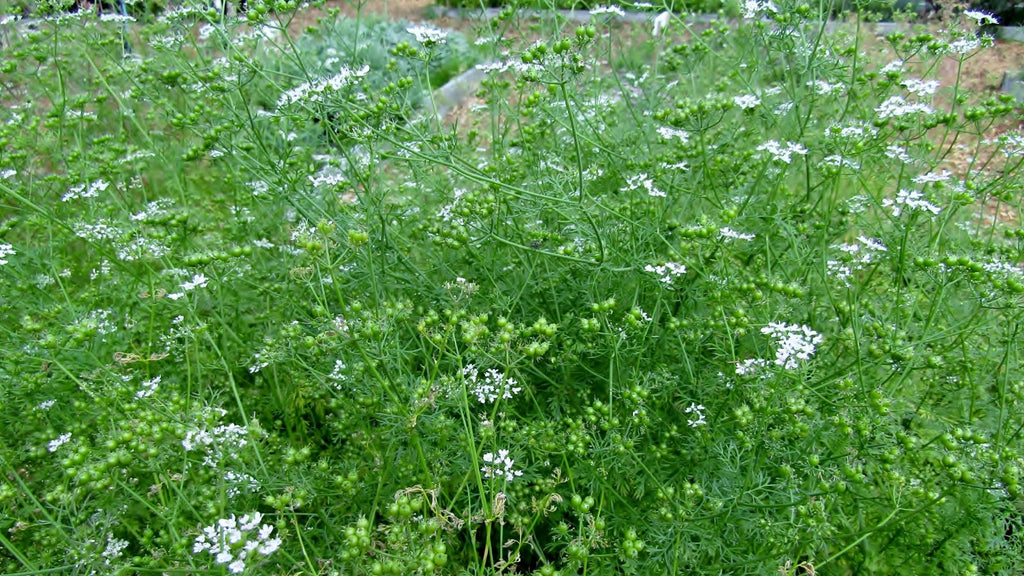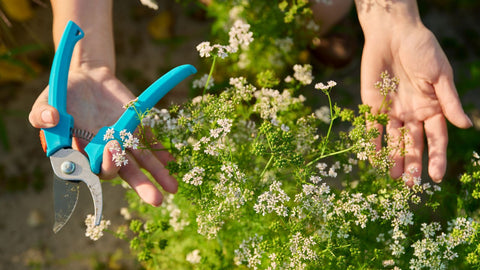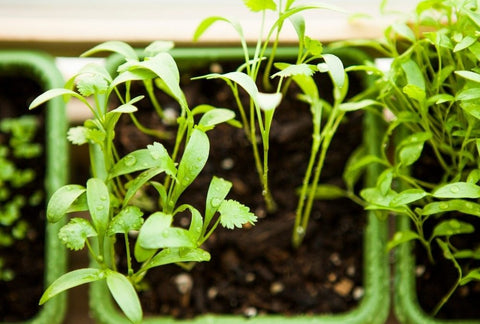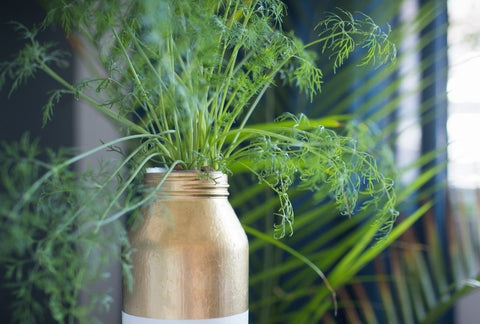Have you been dreaming of a fresh batch of salsa or salad, only to discover that your cilantro has already bolted? Now what?!
"Why is my cilantro plant bolting?” and “What can I do to stop my cilantro from bolting?” are questions we field regularly as Indoor Edible Gardening experts. If you’ve experienced this kitchen emergency, you're in the right place.
Bolting cilantro is a classic culinary conundrum. When growing cilantro for the first time (heck, it even happens to experienced gardeners), you may discover it has already started to bolt before your first harvest. In this blog, you’ll learn that timing is everything, and not everything you read about cilantro bolting online is true. So, what’s really going on with your cilantro plants when they bolt, and is there anything you can do about it?

What Is Bolting, And How Can I Tell If My Cilantro Is Bolting?
Bolting is when the plant shifts into its flowering phase, sending up an elongated flowering stem that develops into an inflorescence. The cilantro plant does this because it senses that its time may be ending, and it wants to create seeds (aka coriander) for the next generation.
Bolting is most often used when referring to biennial plants (like cilantro and broccoli) that live for one or two growing seasons and then die after producing mature seeds for the next generation. Bolting and flowering are natural parts of your plant’s life cycle.
You’ll know your cilantro is about to bolt when you notice a thick central stem developing with smaller, more deeply lobed leaves. You may also notice some yellowing of the foliage, as the plant pulls nutrients from older leaves to fuel flower and seed development. Plants will then get very tall, very quickly. Once you notice this sign of bolting, your herbs are off to the races!
What Causes Cilantro to Bolt?
How Temperature Impacts Cilantro Bolting
The first simple answer is temperature. Cilantro is an annual that thrives in cool to moderate temperatures and bolts when temperatures hit the 70s. Your best cilantro harvest will come when temperatures do not exceed 65-70°F. While you may see recommendations for growing cilantro between 50-85°F, it really depends on your local growing conditions and night temperatures.
For example:
- In New York City, grow cilantro from mid-April through early-November.
- In some parts of California, cilantro can be grown year-round with harvests from March to mid-November.
- In southern California, plant cilantro from late September to November and harvest it from late fall through early spring.
- In the Pacific Northwest, grow cilantro from May through November.
- In Texas, grow cilantro from September through February to early March. You may also be able to get a short crop from planting transplants in February, but it will be a short growing season with bolting occurring in March.
“But wait! You just told me I can grow cilantro at temperatures between 50-85°F….but didn’t you also just tell me it bolts at warm temperatures? 85°F is pretty warm!”
Yes, but you might not have considered the differences in night temperatures between different growing regions. Warm days and cool nights result in a cooler day-night average temperature. In certain hot climates, night temperatures are often as warm or hot as day temperatures, causing plants to bolt sooner.
Photoperiod or Day Length
The next trigger is photoperiod, or day length. Once the day length exceeds 12 hours, your cilantro will set its sights on flowering. The longer the days, the faster the flowering. For example, in Dallas, TX, a 12-hour day happens around March 16, while in New York, it’s around March 18.
While there's nothing anyone can do to change the day length, if you're growing cilantro indoors under grow lights, you have more control and it may be possible to delay the onset of bolting.
How Stress Can Influence Cilantro Bolting
Stress can also trigger cilantro to bolt out of season. Plants under stress, such as too little water or light, may pull all their existing resources to flower and make seeds before they die. If you’re growing your cilantro under the right conditions, this trigger won’t be as common as temperature and photoperiod. But it can happen, so ensure your plants get plenty of light and appropriate amounts of water and nutrients.
Can I REALLY Stop My Cilantro from Bolting?
Unfortunately, no, you can’t stop cilantro from bolting! Nor can you slow it down in any meaningful way.
When cilantro is ready to bolt, it’s going to bolt. Bolting isn’t terrible; it’s what the plant is supposed to do. And there’s really no such thing as a cilantro plant that blooms “too early.” The plant responds to temperature and day length, and when those conditions are favorable for flowering, that’s when it’s the right time for the plant to flower and produce seeds.
Unless you treat your cilantro plants with a plant growth regulator that suppresses gibberellin (a hormone that triggers flowering in cilantro in response to environmental changes), there’s no stopping it! (That was a lot of botany, we’ll try not to do that again…unless you want us to!)
Does Shading Your Cilantro Keep It from Bolting?
Growing cilantro in shadier spots or covering it with shade cloth is a method touted by some to prevent cilantro bolting. While a little shade - either from neighboring plants or shade cloth - or an inch or two of shredded mulch around the plant can keep roots a little cooler (especially in hot climates), remember that reduced light will also reduce leafy growth. These methods won’t prevent bolting, but they might buy you a little bit of extra harvesting time.
Can I Still Eat Cilantro When It Bolts?
If you’re a cilantro lover, you’ll quickly notice an extra bitter flavor to cilantro leaves as soon as plants begin to bolt. Cutting off the flower stalk won’t reverse this change. We recommend allowing them to flower, feeding the pollinators, and harvesting some coriander seeds! Yes, cilantro seeds are known in the kitchen as coriander. Fill up a jar and keep it on hand to spice up your next curry dish.
What To Do When Your Cilantro Has Bolted?
Once your cilantro plant has bolted, there's not much you can do about it. Instead of dwelling on what can't be undone, we recommend:
- Starting over with some high-quality cilantro seeds. Look for 'slow bolt' varieties.
- Check out our 5 Tips For Stopping Cilantro From Bolting.
- Our comprehensive guides on how to grow cilantro indoors or outdoors.
- If you're interested in learning more about cilantro and other plants that can be grown indoors, grab a free copy of our eBook titled 'How To Grow An Indoor Edible Garden' below.








Great, concise info on bolting for a new cilantro gardener. I appreciate you all for the good info